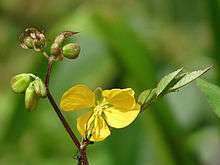Senna occidentalis
Senna occidentalis is a pantropical plant species.[1]
| Coffee senna | |
|---|---|
 | |
| Senna occidentalis flower | |
| Scientific classification | |
| Kingdom: | Plantae |
| Clade: | Tracheophytes |
| Clade: | Angiosperms |
| Clade: | Eudicots |
| Clade: | Rosids |
| Order: | Fabales |
| Family: | Fabaceae |
| Genus: | Senna |
| Species: | S. occidentalis |
| Binomial name | |
| Senna occidentalis | |
| Synonyms | |
|
Cassia caroliniana, C. ciliata Raf.
| |
Vernacular names include ʻauʻaukoʻi in Hawaii, septicweed,[2] coffee senna,[3] coffeeweed, Mogdad coffee, negro-coffee, senna coffee, Stephanie coffee, stinkingweed or styptic weed.
The plant is locally called Bana Chakunda in Odisha, India.
The species was formerly placed in the genus Cassia.
The plant is reported to be poisonous to cattle.[4] The plant contains anthraquinones. The roots contain emodin[5] and the seeds contain chrysarobin (1,8-dihydroxy-3-methyl-9-anthrone) and N-methylmorpholine.[6]
Uses
In Jamaica the seeds are roasted, brewed and served as tea to treat hemorrhoids, gout, rheumatism, and diabetes.

Mogdad coffee seeds can be roasted and used as a substitute for coffee. They have also been used as an adulterant for coffee. There is apparently no caffeine in mogdad coffee.
Despite the claims of being poisonous, the leaves of this plant, Dhiguthiyara in the Maldivian language,[7] have been used in the diet of the Maldives for centuries[8] in dishes such as mas huni and also as a medicinal plant.[9]
This plant is mainly used for the treatment of bone fractures and bone dislocation as an herbal treatment in India.
Toxicity
Almost all parts (leaf, root, seeds) of the plant are used as food and medicine by tribal populations in India. However, consumption of Bana Chakunda seeds has been identified as a possible cause of death of tribal children due to acute Encephalopathy (see Acute HME syndrome).[10][11] Once the plant was identified as the cause, the number of deaths plummeted.[12]
The same thing happened in Rio Grande do Sul, Brazil, where 16 outbreaks were recorded.[13] This was a record in comparison to the clinical study of 1979, at which eight calves died after contracting dyspnea, neutrophilia and tachycardia from consumption of the plant.[14]
Description
C. occidentalis L. Sp. Pl. 377. 1753; DC. Prodr. 2 : 497. 1825 ; Baker, in Hook. F. Fl. Brit. Ind. 2: 262, 1878; Heinig, Enum. 401. 1907 ; Ohashi in Hara, Fl. E. Himal. 144. 1966; Deb. D.B. Fl. Tripura State 1 : 119. 1981; C. planisiliqua L. Sp. Pl. 377. 1753; Senna occidentalis Roxb. Fl. Ind. 2 : 343. 1832.
Plant:- Annual undershrub, subglabrous, foetid, few feet high.
Leaves:- Alternate, compound, paripinnate; rachis channelled, presence of a gland at the base of the rachis; stipulate, stipules obliquely cordate, acuminate; leaflets 4–5 pairs, size (3.7 cm X 2 cm- 7 cm X 3.5 cm), obate to oblong- lanceolate; acuminate, margin ciliate, glabrous or pubescence.
Inflorescence:- Axillary corymb and terminal panicle.
Flowers:- Complete, bisexual, slightly irregular, zygomorphic, pentamerous, hypogynous, pedicelate; bractate, bracts white with pinkish tinge, thin, ovate- acuminate, caducous; yellow.
Calyx:- Sepals 5, gamosepalous, tube short, 5 lobed, obtuse, glabrous, imbricate, odd sepal is anterior.
Corolla:- Petals 5, polypetalous, alternisepalous, sub-equal, with distinct claw, conspicuously veined, ascending imbricate, posterior petal is the innermost.
Androecium:- Stamens 10, free, unequal in size, 7 perfect and 3 reduced to staminode, filaments unequal, anther dithecous, basifixed, introrse and dehiscing by terminal pores.
Gynoecium:- Carpel 1, ovary superiour, unilocular, many ovuled, marginal placentation; style simple; stigma terminate, capitate.
Fruit:- Pod, dehiscent, woody, 12.5 cm X 0.7 cm, glabrous, recurved, subcompressed, distinctly torulose, 23-30 seeded.
References
- "Senna occidentalis". Germplasm Resources Information Network (GRIN). Agricultural Research Service (ARS), United States Department of Agriculture (USDA). Retrieved 2009-03-28.
- "Senna occidentalis". Natural Resources Conservation Service PLANTS Database. USDA. Retrieved 10 November 2015.
- "Plant species and sites" (PDF). Government of Australia. Retrieved 1 May 2018. Cite journal requires
|journal=(help) - Barth, AT; Kommers, GD; Salles, MS; Wouters, F; de Barros, CS (1994). "Coffee Senna (Senna occidentalis) poisoning in cattle in Brazil". Vet Hum Toxicol. 36 (6): 541–5. PMID 7900275.
- Chukwujekwu, J.C.; Coombes, P.H.; Mulholland, D.A.; van Staden, J. (2006). "Emodin, an antibacterial anthraquinone from the roots of Cassia occidentalis". South African Journal of Botany. 72 (2): 295–297. doi:10.1016/j.sajb.2005.08.003.
- Kim, Hyeong L.; Camp, Bennie J.; Grigsby, Ronald D. (1971). "Isolation of N-methylmorpholine from the seeds of Cassia occidentalis (coffee senna)". Journal of Agricultural and Food Chemistry. 19 (1): 198–199. doi:10.1021/jf60173a026. PMID 5540753.
- "Thimaaveshi - Catalogue of Plants - Edition II" (PDF). October 2009.
- "List of food items in 'Maldives Coding System'" (PDF). Archived from the original (PDF) on 2012-10-04. Retrieved 2011-09-12.
- Xavier Romero-Frias (2003). The Maldive Islanders, A Study of the Popular Culture of an Ancient Ocean Kingdom. Nova Ethnographia Indica. ISBN 8472548015.
- "Experts' report on Malkangiri kids death evokes mixed reaction". 19 November 2016. Retrieved 1 May 2018.
- Nadiya Chand Kanungo (25 November 2016). "Strange: Now M'giri kids' deaths linked to Chakunda Plant rather rich in medicinal properties". The Daily Pioneer. Bhubaneswar. Retrieved 1 May 2018.
- Vashishtha VM; Kumar A; John TJ; Nayak NC. (2007). "Cassia occidentalis poisoning as the probable cause of hepatomyoencephalopathy in children in western Uttar Pradesh" (PDF). Indian Journal of Medical Research. 125 (6): 756–762. PMID 17704552.
- Carmo, Priscila M.S.; Irigoyen, Luiz Francisco; Lucena, Ricardo B.; Fighera, Rafael A.; Kommers, Glaucia D.; Barros, Claudio S.L. (February 2011). "Spontaneous coffee senna poisoning in cattle: report on 16 outbreaks". Pesquisa Veterinária Brasileira. Rio de Janeiro. 31 (2): 139–146. doi:10.1590/S0100-736X2011000200008.
- Rogers, R.J.; Giboson, J.; Reichmann, K.G. (September 1979). "The Toxicity of Cassia occidentalis for Cattle". Australian Veterinary Journal. 55 (9): 408–412. doi:10.1111/j.1751-0813.1979.tb05590.x.
External links
| Wikispecies has information related to Senna occidentalis |
| Wikimedia Commons has media related to Senna occidentalis. |